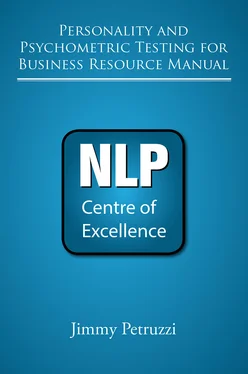
Disclaimer
The author and publisher of this resource manual have put in their best efforts for its preparation. Both, the publisher and the author, make no guarantees or representation in terms of accuracy, applicability or completeness of this resource manual content. The information this resource manual contains is strictly for informational purposes. Hence, when applying any concepts stated in this resource manual, you are to accept complete responsibility for your actions.
Every possible effort has been made to represent the information accurately. However, there is no guarantee that using these techniques will result in perfect employment, promotional or other workplace decisions. The use of the examples given in this resource manual cannot be interpreted as a guarantee and promise to provide 100% positive results.
The author and publisher do not warrant the performance, effectiveness or applicability of any personal assessment tools stated in this resource manual. Employers reading this resource manual for guidance are advised to have their own personal assessment instruments made based on these models and their requirements. The company doesn't claim responsibility of any dispute or misunderstanding that arises due to miscommunication or readers' inability to understand.
Table of Contents
Contents
Disclaimer Disclaimer The author and publisher of this resource manual have put in their best efforts for its preparation. Both, the publisher and the author, make no guarantees or representation in terms of accuracy, applicability or completeness of this resource manual content. The information this resource manual contains is strictly for informational purposes. Hence, when applying any concepts stated in this resource manual, you are to accept complete responsibility for your actions. Every possible effort has been made to represent the information accurately. However, there is no guarantee that using these techniques will result in perfect employment, promotional or other workplace decisions. The use of the examples given in this resource manual cannot be interpreted as a guarantee and promise to provide 100% positive results. The author and publisher do not warrant the performance, effectiveness or applicability of any personal assessment tools stated in this resource manual. Employers reading this resource manual for guidance are advised to have their own personal assessment instruments made based on these models and their requirements. The company doesn't claim responsibility of any dispute or misunderstanding that arises due to miscommunication or readers' inability to understand.
Executive Summary Executive Summary This resource manual provides an insight into the increasing use and importance of personality and psychological testing at the workplace. Employers nowadays do not prefer to recruit potential employees only on the basis of their academic qualifications. Personality, being a significant part of a person, is also evaluated and judged to consider whether a certain candidate is suitable for a particular position or specific job responsibilities. Therefore, personality and psychological tests were developed to scrutinize and evaluate candidates. These tests are based on certain models or methods that have been devised by psychological and personality experts. The tests have been revised over and over again to provide more reliable and accurate results. These models have been well-defined and explained with useful examples for your knowledge. In this resource manual, you will find valuable information regarding various personal assessment instruments. There are sample tests based on various personality assessment models to help you understand the kind of questions that are asked in such personality tests and the elements they aim to explore of a candidate’s personality and capabilities. Moreover, the resource manual contains charts and tables to help you gain an in-depth understanding of the subject. In addition to that, the importance, benefits and limitations of such testing in the workplace has been explained point by point for your information. This guide will help you know more about workplace testing and its various elements.
Introduction Introduction Competent and skilled human resource is the basic and most crucial ingredient required for the success of a business. Companies spend a huge amount of money on recruitment annually. Over the years, firms have realized that the process of recruitment needs to include psychometric and personality tests in order to analyse and evaluate the capability and personality of candidates. These tests provide nearly accurate results, enabling recruitment personnel to make better hiring decisions. Employers, with the help of these tests, are better able to decide which personality type will be suitable for specific jobs. Conducting such tests while hiring can reduce turnover and save valuable company resources. By recruiting the right people the first time, firms can save themselves the task of recruiting and training the wrong people and then having to replace them. This manual sheds light on the importance of using psychometric and personality tests in the field of business, providing employers a better way of recruiting and ensuring that potential employees are suitable for certain positions. It also includes real life examples that can be used to measure the effectiveness of and implement personality and psychometric tests in business.
What is a Personality Test? What is a Personality Test? Figure 1 Image courtesy of Stuart Miles / FreeDigitalPhotos.net A personality test is usually a questionnaire or any reliable instrument that is created to reveal a person's personality traits that are appropriate for the workplace. These tests do not have any right answers. They are just designed in order to test whether a certain candidate has the experience and skills required to work in a certain position. They also test if a potential employee is motivated enough to take up responsibility and perform their tasks efficiently. Moreover, these tests also help disclose the candidate's attitude and their possible behaviour in case they are asked to work in teams with people of similar or diverse personalities. One of the most popular personality tests is the Myers-Briggs Type Indicator. In this test, candidates are given choices and are required to choose one option. This test reveals how people generally make decisions, judge themselves and perceive the world around them.
What is a Psychological Test? What is a Psychological Test? Psychological testing is used in order to recruit the right people. If firms hire a candidate on the basis of their skills and experience and do not conduct psychometric tests, they will not be able to know how a potential employee will react in a challenging situation or whether the candidate will be able to work under stress. Psychological tests measure a candidate’s strengths and weaknesses and confirm if the candidate is suitable for a specific position or not. They also measure whether a candidate would be able to process conceptual and numerical information and make wise decisions. This enables employers to delegate responsibilities effectively. These tests are not only used during screening and selection, but can also be conducted when making decisions regarding promoting current employees.
Personality – An Insight
How is Personality Measured?
What do these Tests Measure?
Why Measure Personality?
Importance of Personality and Psychometric Testing in Business
Читать дальше













